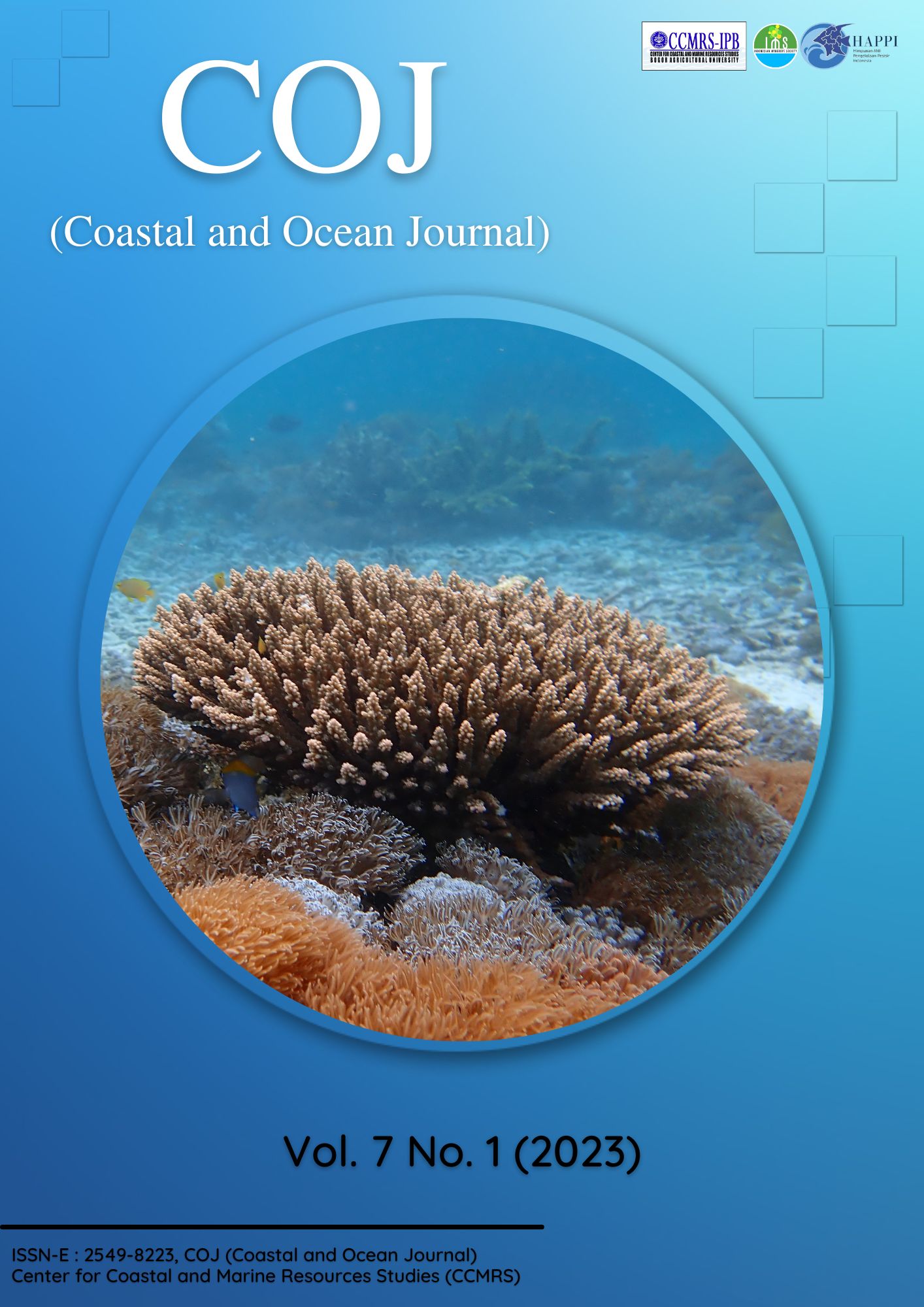DNA BARCODING UNTUK VALIDASI SPESIES PAUS SPERMA (Physeter macrocephalus LINNAEUS, 1758) DARI PERAIRAN LAUT SAWU, NUSA TENGGARA TIMUR, INDONESIA
Abstrak
Paus sperma (Physeter macrocephalus) merupakan salah satu biota laut yang dilindungi di Indonesia. Identifikasi molekuler paus sperma dari perairan Laut Sawu (Nusa Tenggara Timur, Indonesia) telah dilakukan menggunakan gen 16S rRNA. Penelitian ini bertujuan untuk menvalidasi spesies paus sperma (Physeter macrocephalus) di Indonesia menggunakan gen cytochrome oxidasesubunit I (COI) parsial. Spesimen yang digunakan merupakan spesimen jaringan dari koleksi laboratorium yang diambil dari perairan Laut Sawu tahun 2014. Ketiga spesimen tervalidasi sebagai Physeter microcephalus dengan kemiripan sebesar 100%. Komposisi basa didominasi oleh basa timin (31,7-31,8%) dengan GC konten sebesar 42,7–42,8%. Jarak genetik pada spesies yang sama didapatkan nilai sebesar 0,0015, sedangkan jarak genetik tertinggi dengan spesies Orcaella brevirostris sebesar 0,2128. Identifikasi molekuler menggunakan gen 16S rRNA dan COI telah menvalidasi spesies paus sperma (Physeter macrocephalus) di Indonesia, sehingga data genetik ini dapat digunakan sebagai dasar pengelolaan dan konservasi sumberdaya paus sperma.
Unduh
Referensi
Amaral, A.R., Jackson, J.A., Möller, L.M., Beheregaray, L.B., Coelho, M.M. 2012. Species tree of a recent radiation: The subfamily Delphininae (Cetacea, Mammalia). Molecular Phylogenetic and Evolution 64, 243–253.
Cantor, M., Gero, S., Whitehead, H., Rendell, L. 2019. Sperm whale: The largest toothed creature on Earth. In B. Würsig (Ed.), Ethology and ecology of marine mammals 261-280.
DeSalle, R., Goldstein, P. 2019. Review and interpretation of trends in DNA barcoding. Front. Ecol. Evol. 7, 302.
DeSalle, R., Schierwater, B., Hadrys, H. 2017. MtDNA: The smallworkhorse of evolutionary studies. Front Biosci-Landmark 22(5), 873-887.
Desrianti. F. 2011. Perubahan sosial masyarakat nelayan Lamalera (sudut pandang sosiologi ekonomi dan ekologi) [disertasi], Bogor (ID): Institut Pertanian Bogor.
Dexter, K.G., Lavin, M., Torke, B.M., Twyford, A.D., Kursar, T.A., Coley, P.D., Drake, C., Hollands, R., Pennington, R.T. 2017. Dispersal assembly ofrain forest tree communities across the Amazon basin. Proc Nat AcadSci 114(10), 2645-2650.
Doğan, İ., Doğan, N. 2016. Genetic distance measures: Review. Turkiye Klinikleri J Biostatistics 8, 87-93.
Elías-Gutiérrez, M., Hubert, N., Collins, R.A., Andrade-Sossa, C. 2021. Aquatic organisms research with DNA barcodes. Diversity 13, 306.
Felsenstein J. 1985. Confidence limits on phylogenies: An approach usingthe bootstrap. Evolution 39, 783-791.
Foote, A.D., Thomsen, P.F., Sveegaard, S., Wahlberg, M., Kielgast, J., et al. 2012. Investigating the potential use of environmental DNA (eDNA) for genetic monitoring of marine mammals. PLoS ONE 7(8), e41781.
Galimberti, A., Sandionigi, A., Bruno, A., Bellati, A., Casiraghi, M. 2015. DNA barcoding in mammals: what's new and where next? Hystrix It. J. Mamm 26(1), 13–24.
Hakim, A.A., Kamal, M.M., Butet, N.A., Affandi, R. 2020. Taxonomic status investigation of freshwater eels (Anguilla spp.) based on themolecular marker in seven rivers that flow to Palabuhanratu Bay,Indonesia. IOP Conf Ser Earth Environ Sci 420, 012012.
Hakim, A.A., Dikrurahman, Muhlis, S., Astuti, R.P., Sari, D.W., Kamal, M.M. 2022a. A genetic approach for authentication on morphological differences of cultivated pompano species in Indonesia. Biodiversitas 23, 4561-4569.
Hakim, A.A., Sidabutar, Y.N., Mashar, A., Zairion, Imran, Z., Wardiatno, Y. 2022b. Application of cytochrome oxidase subunit 1 partial gene forspecies validation of Macrobrachium sintangense from Lake Lido,West Java. IOP Conf Ser Earth Environ 1033, 012001.
Hebert, P.D.N., Cywinska, A., Ball, S.L., de Waard, J.R. 2003. Biological identifications through DNA barcodes. Proceedings of the Royal Society of London 270, 313-322.
IJsseldijk, L.L., van Neer, A., Deaville, R., Begeman, L., van de Bildt, M., van den Brand, J.M.A., et al. 2018. Beached bachelors: An extensive study on the largest recorded sperm whale Physeter macrocephalus mortality event in the North Sea. PLoS ONE 13(8), e0201221.
Kamal, M.M., Butet, N.A., Rahayu, E.S., Hakim, A.A. 2021. Identifikasi karakterstik molekuler gen 16S rRNA parsial pada paus sperma (Physeter macrocephalus Linnaeus, 1758). Habitus Aquatica 2(1), 21–28.
Kamal, M.M., Hakim, A.A., Butet, N.A., Fitrianingsih, Y., Astuti, R. 2019. Autentikasi spesies ikan kerapu berdasarkan marka gen MT-COI dari perairan Peukan Bada, Aceh. Jurnal Biologi Tropis 19(2), 116–123.
Keijl, G.O., Groenenberg, D.S.J., Nieman, A.M., Desjardins, R.B., Gravendeel, B. 2019. Molecular identification of sei whales (Balaenoptera borealis) from the Netherlands. Lutra 62(1), 3-11.
Kreb, D.P., Mustika, B., Kahn, A., Yanuar, Muhajir. 2013. National reviews of status, research, catch, by-catch, conservation and legislation of marine mammals in Indonesia: A Country Report to the 3rd Southeast Asian Marine Mammal Symposium. Langkawi, 3rd Southeast Asian Marine Mammal Symposium.
Krisanti, M., Ramadhan, B.F., Mashar, A., Butet, N.A., Hakim, A.A., Wardiatno, Y. 2020. Mole crab phylogenetics relationship analysis inParangkusumo and Ketawang Beach Waters. IOP Conf Ser EarthEnviron Sci 420, 012018.
Lakra, W.S., Verma, M.S., Goswami, M., et al. 2011. DNA barcoding Indian marine fishes. Molecular Ecology Resources 11, 60–71.
Larkin, M.A., Blackshields, G., et al. 2007. Clustal W and Clustal X version2.0. Bioinformatics 23(21), 2947-2948.
Morin, P.A., Alexander, A., Hancock-Hanser, B.L., Foote, A.D., Mesnick, S.L., Rosel, P.E. 2016. Genomic diversity and historical demography of the sperm whale (Physeter macrocephalus); from bottleneck to global distribution. [unpublished]
Ponganis, P.J. 2015. Diving physiology of marine mammals andseabirds. Cambridge: Cambridge University Press.
Ren, X., Ma, X., Allen, E., Fang, Y., Wen, S. 2022. DNA barcoding technology used to successfully sub-classify a museum whale specimen as Balaenoptera edeniedeni. Front. Ecol. Evol. 10, 921106.
Roman, J., Altman, I., Dunphy-Daly, M. M., Campbell, C., Jasny, M., Read, A.J. 2013. The Marine Mammal Protection Act at 40: status, recovery, and futureof U.S. marine mammals. Ann. N. Y. Acad. Sci. 1286, 29–49.
Rudolph, P., Smeenk, C., Leatherwood, S. 1997. Preliminary checklist of cetacea in the Indonesian Archipelago and Adjacent Waters. Zoologische Verhandelingen 312, 3-24.
Saitou, N., Nei, M. 1987. The neighbor-joining method: A new method forreconstructing phylogenetic trees. Mol Biol Evol 4, 406-425.
Sanger, F., Nicklen, S., Coulson, A.R. 1977. DNA sequencing with chainterminating inhibitors. Proc Natl Acad Sci USA 74, 5463-5467.
Schwartz, M.K., Luikart, G., Waples, R.S. 2007. Genetic monitoring as a promising tool for conservation and management. Trends Ecol Evol 22, 25–33.
Silva, V.S., Skueresky, N., Lopes, F. et al. 2021. Integrating morphology and DNA barcoding to assess cetacean diversity in Brazil. Mamm Res 66, 349–369.
Suarez-Bregua, P., lvarez-Gonza ́lez, A.M., Parsons, K.M., Rotllant, J., Pierce, G.J., Saavedra, C. 2022. Environmental DNA (eDNA) for monitoring marine mammals: Challenges and opportunities. Front. Mar. Sci. 9, 987774.
Székely, D., Cammen, K. M., & Tange Olsen, M. 2022. Needles in an ocean haystack: using environmental DNA to study marine mammals in the North Atlantic. NAMMCO Scientific Publications. NAMMCO Scientific Publications 12.
Taberlet, P., Coissac, E., Hajibabaei, M., Rieseberg, L.H. 2012. Environmental DNA. Mol. Ecol. 21, 1789–1793.
Tallei, T.E., Rembet, R.E., Pelealu, J.J., Kolondam, B.J. 2016. Sequencevariation and phylogenetic analysis of Sansevieria trifasciata(asparagaceae). Biosci Res 13, 1-7.
Tamura, K., Stecher, G., Kumar, S. 2021. MEGA11: Molecular Evolutionary Genetics Analysis Version 11. Mol Biol Evol 38(7), 3022-3027.
Taylor, B.L., Baird, R., Barlow, J., Dawson, S.M., Ford, J., Mead, J.G., Notarbartolo di Sciara, G., Wade, P. & Pitman, R.L. 2019. Physeter macrocephalus (amended version of 2008 assessment). The IUCN Red List of Threatened Species e.T41755A160983555.
Teletchea, F. 2009. Molecular identificationmethods of fish species: Reassessment andpossible applications. Rev Fish Biol Fish 19(3), 265–293.
Viricel, A., Rosel, P.E. 2012. Evaluating the utility of COI for cetacean species identification. Marine Mammal Science 28, 37–62.
Yusmalinda, N.L.A., Anggoro, A.W., Suhendro, D.M., Ratha, I.M.J., Suprapti, D., Kreb, D., Cahyani, N.K.D. 2017. Identifikasi jenis pada kejadian cetacea terdampar di Indonesia dengan teknik molekuler. Jurnal Ilmu dan Teknologi Kelautan Tropis 9(2), 465-474.







